Brake System Bleeding And Flushing For All Vehicles: What & Which
Maintaining your brakes is critical for the safety of you and other drivers on the road. Brake pads and rotors must be replaced regularly, but a brake bleed or flush could also be necessary. So what’s the difference?
When a vehicle needs a brake bleed, brake fluid is drained from the master cylinder and bled from each wheel until all air bubbles are forced out of the lines. This ensures that your brakes perform precisely as they should. A brake flush removes old fluid from the system and introduces new fluid. This keeps corrosion at bay, slows down internal damage, and improves overall performance.
It’s usually done when there’s worn lining in hydraulic components like ABS systems or the master cylinder or if there’s been any servicing of hydraulic components. Knowing when to perform is key to ensuring you always keep your brakes in tip-top shape. Dig into and learn more about this fact.
Table of Contents
What is Brake System Bleeding and Flushing?
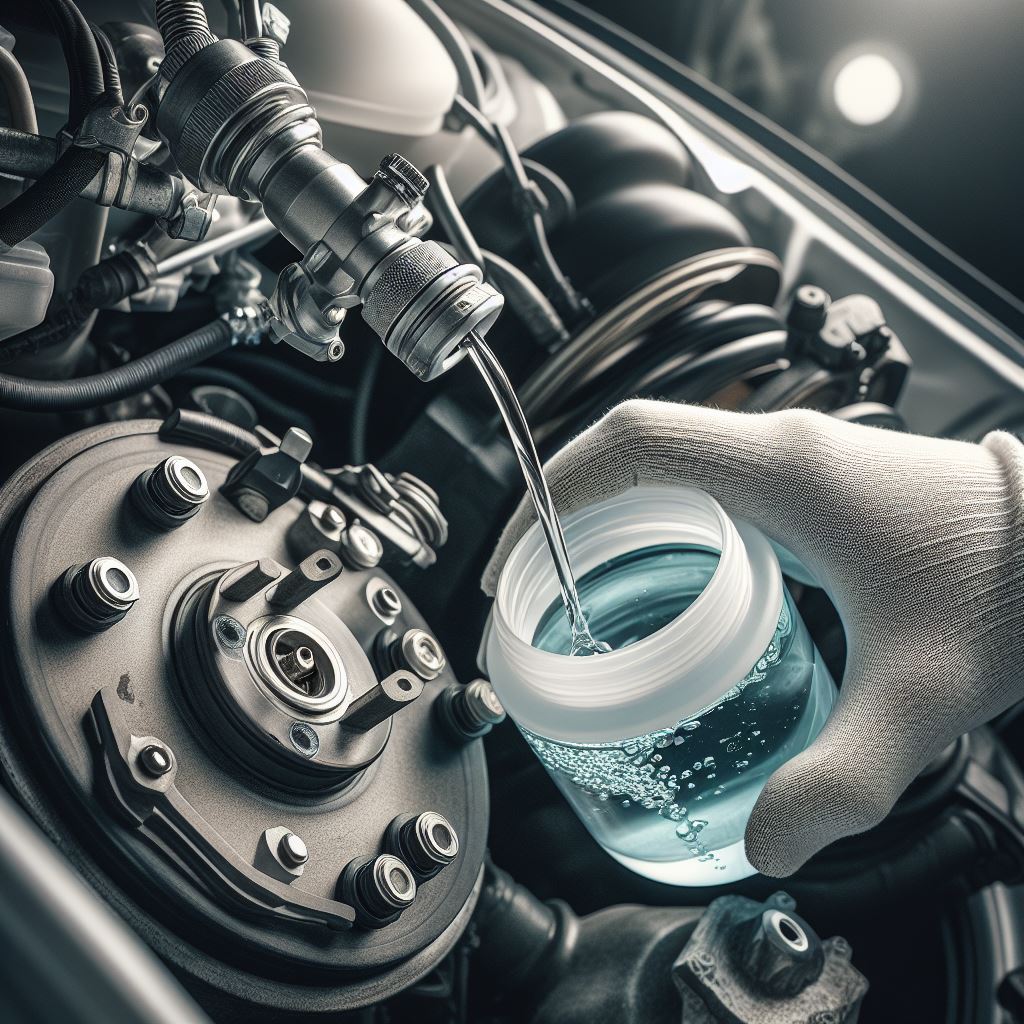
Brake system bleeding and flushing may sound like complicated procedures, but they are actually essential for the proper functioning of your vehicle’s brakes. Let’s break it down. First, let’s define what brake system bleeding and flushing actually mean.
Brake system bleeding involves removing air bubbles from the brake lines, which can affect the pressure and responsiveness of the brakes. On the other hand, flushing refers to completely replacing the brake fluid, which can become contaminated over time and affect the overall performance of the brake system. Now, you may be wondering why these procedures are necessary.
Well, just like any other fluid in your vehicle, brake fluid can deteriorate and become less effective over time. This can lead to spongy brakes, longer stopping distances and even brake failure. Brake system bleeding and flushing ensure that your brakes are working at their optimal level, keeping you and your passengers safe on the road.
But what about the “for all vehicles” part of the title? That’s right, brake system bleeding and flushing are crucial for all types of vehicles, whether it’s a car, truck, or motorcycle. It’s a maintenance task that should not be overlooked, regardless of the type of vehicle you drive. Now, which one should you do first? While brake system flushing is a more in-depth process, it is recommended to do it before bleeding the brakes.
This is because flushing will remove all the old, contaminated brake fluid, and bleeding will ensure there are no air pockets left in the system. So, make sure to schedule these tasks regularly to keep your brake system in top condition. Your vehicle and your safety will thank you.
Why is Brake System Bleeding and Flushing Necessary for All Vehicles?
When it comes to the safety and performance of your vehicle, the brake system is undoubtedly one of the most crucial components. It ensures that you can stop your car safely and effectively, avoiding any potential accidents on the road. However, over time, air and moisture can enter the brake system, causing it to become less efficient and potentially compromising your safety.
This is where brake system bleeding and flushing come into play. These maintenance procedures involve removing old brake fluid and replacing it with fresh, clean fluid to ensure that your brakes are working at their best. But why is it necessary for all vehicles? Firstly, brake system bleeding and flushing help to remove any air bubbles that may have formed in the brake lines.
These bubbles can cause a spongy or soft brake pedal, making it difficult to stop your vehicle quickly. By bleeding and flushing the system, you can ensure that your brakes are responsive and reliable. Additionally, moisture can also build up in the brake fluid over time, which can lead to corrosion and damage to the brake system.
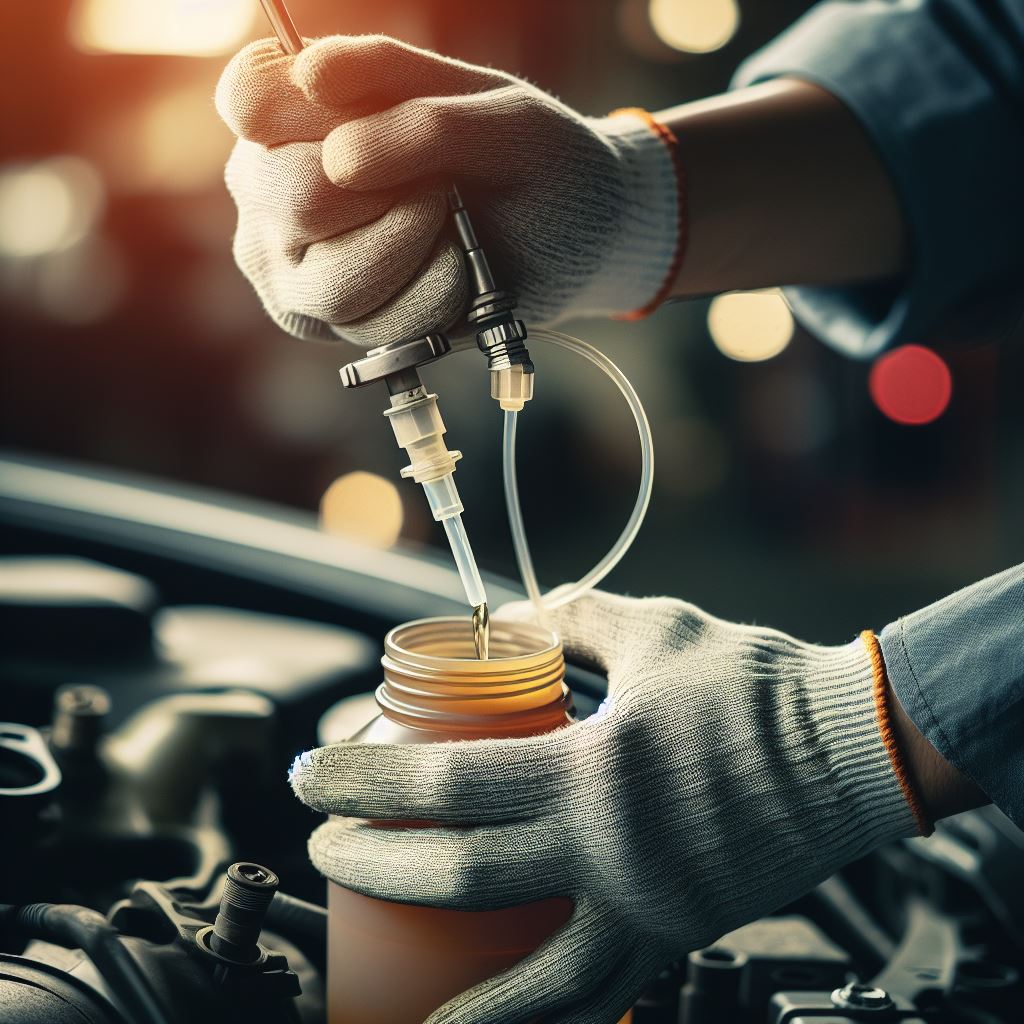
Flushing the system removes any old fluid that may have absorbed moisture and replaces it with fresh, dry fluid, prolonging the life of your brake components. So, which vehicles require brake system bleeding and flushing? The answer is all vehicles! No matter the make, model, or age of your car, regular maintenance of the brake system is crucial for your safety and the longevity of your vehicle. It is recommended to have your brake system flushed every 30,000-60,000 miles or as specified by your vehicle’s manufacturer.
Brake system bleeding and flushing are necessary for all vehicles to ensure optimal brake performance and safety. So, please don’t neglect this essential maintenance procedure and make sure to schedule it regularly for your peace of mind on the road. After all, you can’t put a price on your safety and that of others.
Preserving the Integrity of Your Braking System
Maintaining the functionality of your vehicle’s braking system is crucial for your safety on the road. One important aspect of this is regular brake system bleeding and flushing. This process involves removing old brake fluid and replacing it with fresh, clean fluid to ensure optimal performance.
It is recommended to have this done every 2 years or 30,000 miles, whichever comes first. It’s important to note that the specific method and frequency may vary depending on your vehicle’s make and model. Consult your owner’s manual or a trusted mechanic for the best approach for your car.
Ensuring Optimal Performance and Safety
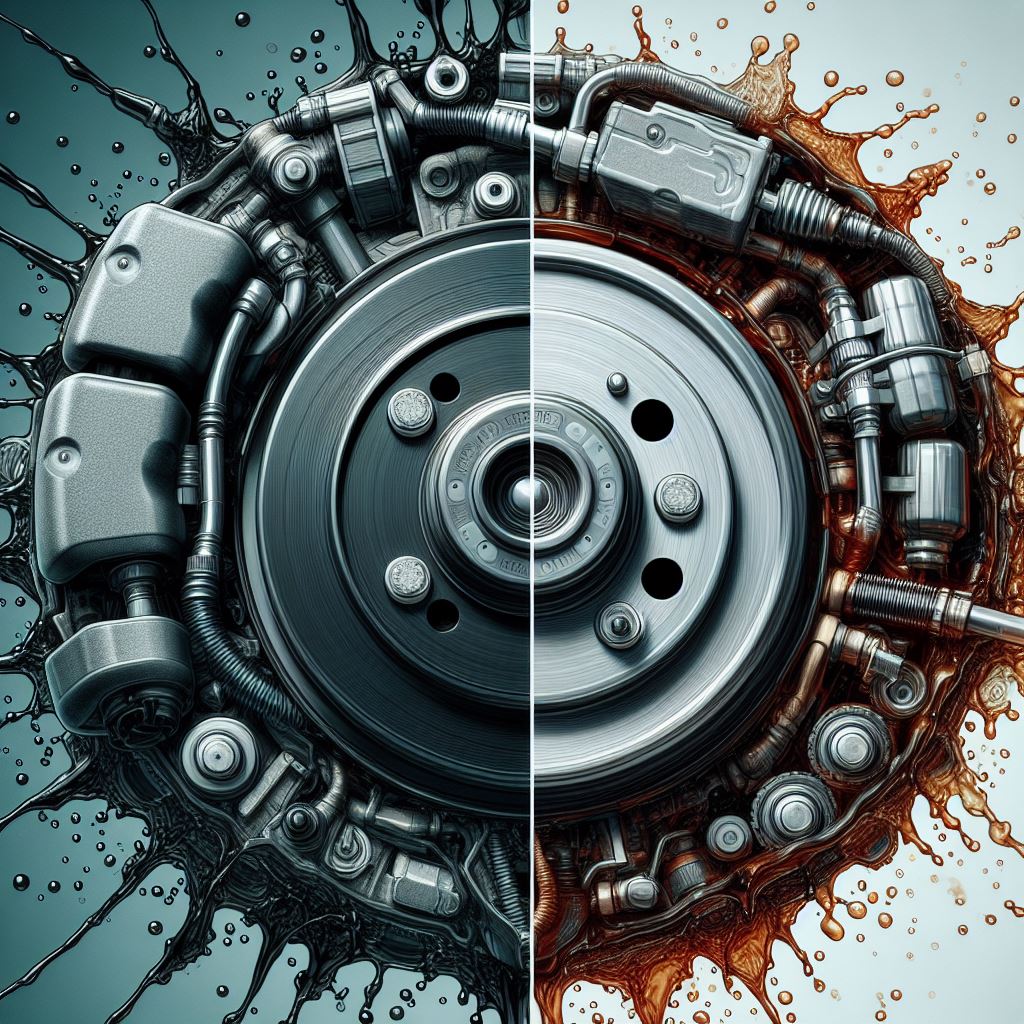
Maintaining optimal performance and safety for your vehicle should always be a top priority. One crucial aspect of this is ensuring that your brake system is functioning properly. Brake system bleeding and flushing are two essential maintenance procedures that can help keep your brakes in top shape.
But what exactly do these terms mean, and which vehicles require them? Brake system bleeding refers to removing air bubbles from the brake lines, while flushing involves replacing old brake fluid with new. Both procedures are crucial for all vehicles to ensure efficient and safe braking.
Preventing Costly Repairs and Replacements
Maintaining a healthy brake system is crucial for the safety and longevity of your vehicle. One key process that often gets overlooked is brake system bleeding and flushing. This involves removing old brake fluid and replacing it with fresh fluid to prevent corrosion and buildup that can lead to costly repairs and replacements.
But what exactly is brake system bleeding and flushing, and which vehicles need it? Let’s dive into the details to keep your brakes in top shape and avoid unnecessary expenses.
Difference Between a Brake Bleed and Flush:
A brake bleed and a brake flush are two methods to ensure maximum braking power in your vehicle. A brake bleed involves pumping fresh brake fluid into the system, thus eliminating any air bubbles that may have formed.
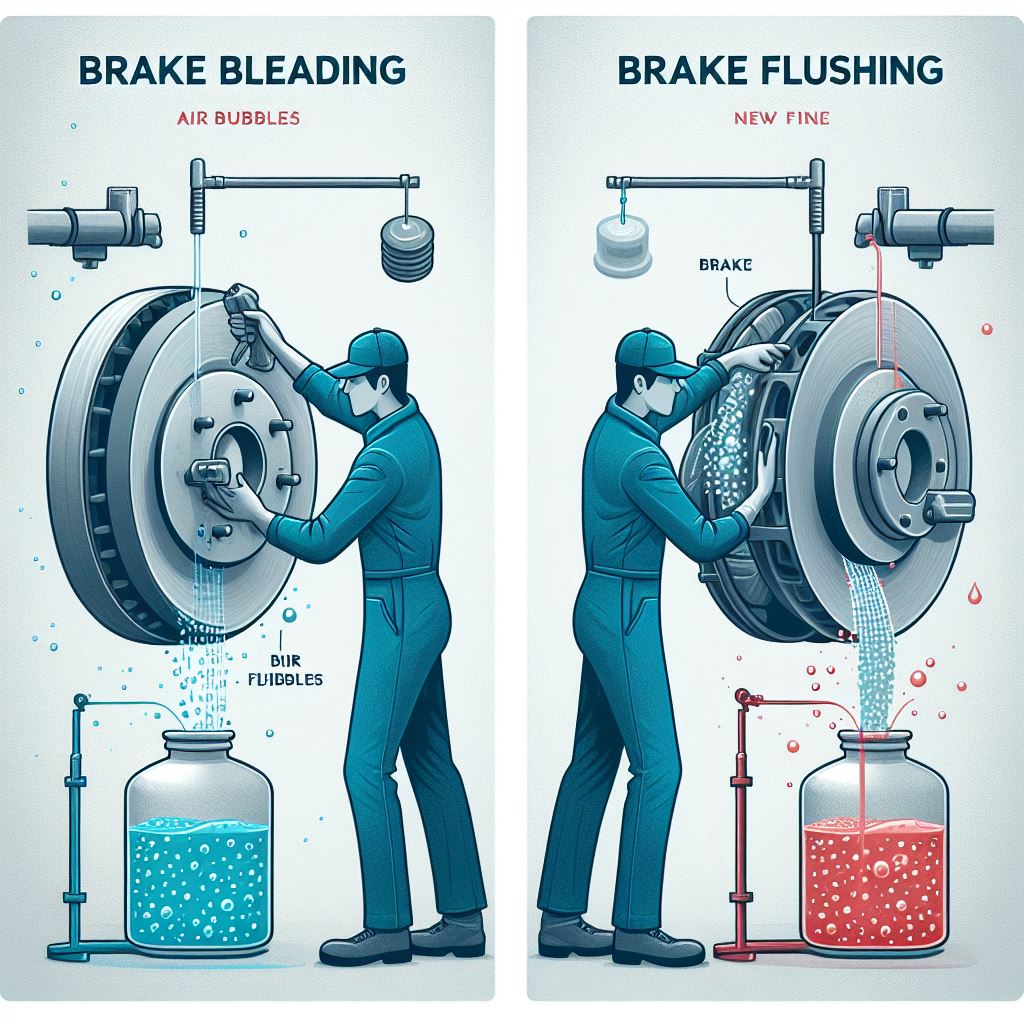
Air bubbles can interfere with pressure transmission within the braking system, reducing effectiveness. If you’ve noticed that your brakes are not as effective as they used to be, it is likely recommended that you will need to perform a brake bleed.
On the other hand, a brake flush involves draining all the current fluid from the brake lines and replacing it with new fluid. While a brake bleed addresses potential air bubbles inside the system, a flush removes all existing contaminants from the old fluid, which could reduce efficiency or even introduce new problems to your brakes.
It is important to note that when performing either a bleed or a flush on your brakes, ensure you never mix fluids such as DOT 3/4 or DOT 5, as this can cause compatibility issues and damage certain components of your braking system.
How Does Brake Fluid Go Bad?
Brake fluid is essential to properly functioning your vehicle, as it helps create the hydraulic pressure necessary to apply the brakes. Over time, however, brake fluid can start to break down and go bad.
This deterioration can be caused by several things, including air or moisture absorbed in the fluid, dirt, and debris from other system parts and frequent exposure to high temperatures.
When brake fluid has gone bad, it will reduce your brakes’ effectiveness and make it more difficult for you to stop quickly and safely. To prevent this from happening, you should check your brake fluid regularly (at least twice a year) for signs of wear and tear.
If you notice any change in color or viscosity, have it checked out immediately by a professional mechanic as soon as possible before it becomes an issue.
Additionally, other components, such as brake lines, should be inspected frequently to confirm they are free of any obstructions that could lead to contamination and trigger a need for replacement brake fluid sooner than expected.
Which One is Better?
Generally speaking, when servicing your brakes, you need not introduce air into the system or allow the fluid level to become completely drained. Your best bet is usually to follow what the manufacturer of your vehicle recommends regarding maintenance. For example, if there’s no recommendation for flushing your brakes, it might not be necessary.

In this scenario, if you’ve been keeping up with recommended service intervals and changing out the brake fluid regularly – usually every 30,000 miles or so – the fluid looks clear and free from contaminants. Bleeding your brakes may be all that’s needed.
In contrast, if you haven’t kept on top of your car’s maintenance schedule and notice that the brake fluid has become murkier, then it might be time for a full flush. Always check what’s suggested in your owner’s manual or service booklet first.
Brake Bleeding Frequency
The frequency with which brakes need to be bled depends on the type and condition of your vehicle. There’s no need to bleed for typical OEM braking systems unless you open the system for repair or replacement. For everyday town/ highway driving, it isn’t necessarily required either. However, on certain European cars, quarterly brake fluid replacement is necessary.
Additional bleeding may be recommended if you drive in a sporting manner or put your car through high-speed braking events or driver schools/lapping sessions – these would be ideal times to do a thorough ‘start-of-the-season maintenance check and brake flush. Regardless of your circumstances, always consult manufacturer instructions or your service center when determining how often you should bleed your brakes.
When to Bleed and Flush Your Brake System
Brakes are an essential component of any vehicle, ensuring our safety on the road. And just like any other system, they require regular maintenance to function properly. One crucial maintenance task is bleeding and flushing the brake system.
But what exactly does this entail, and when should you do it? To put it simply, brake system bleeding and flushing involves removing old brake fluid and replacing it with new, clean fluid. This is important because, over time, brake fluid can absorb moisture and become contaminated, leading to decreased braking performance. It’s like trying to drive with wet shoes – not very effective, right? Now, you may be wondering, what exactly is the difference between bleeding and flushing? Well, bleeding is the process of removing air bubbles from the brake lines, while flushing is the complete replacement of old fluid with new.
Both are equally important and should be done regularly, as recommended by your vehicle’s manufacturer. So, when should you bleed and flush your brake system? The answer is simple – whenever you notice any change in your braking performance. This could be a spongy or soft brake pedal, a longer stopping distance, or a strange noise when applying the brakes.
These are all signs that it’s time to give your brake system some much-needed attention. But don’t wait for these symptoms to show up before taking action. It’s always a good idea to include brake system bleeding and flushing in your regular maintenance schedule.
Typically, this should be done every 2-3 years, depending on your driving habits and the type of brake fluid used in your vehicle. Now, the big question – what type of brake fluid should you use? The answer is simple – always refer to your vehicle’s manual. Each vehicle may have different requirements, and using the wrong type of fluid can cause serious damage to your brake system.
So, be sure to use the recommended type for optimal performance. Brake system bleeding and flushing may not be the most exciting maintenance task, but it’s crucial for your safety on the road. Don’t neglect this important aspect of vehicle maintenance, and always refer to your manual for the best results.
Recommended Maintenance Schedule
Maintaining your vehicle’s brake system is crucial for safe driving. One important aspect is bleeding and flushing the brake system regularly. This process involves removing old brake fluid and replacing it with new fluid to prevent corrosion and maintain proper brake function.
It is recommended to bleed and flush your brake system every 2 years or 30,000 miles, whichever comes first. Remember, different vehicles may require different types of brake fluid, so always check your owner’s manual for the correct type. Don’t neglect this maintenance task – it could save your life on the road.
Signs that Your Brake System Needs Bleeding and Flushing
Brake system bleeding and flushing may not be the most exciting topic, but it’s an important aspect of vehicle maintenance. Signs that your brake system needs this service include a spongy or soft brake pedal, longer stopping distances, and a decrease in overall braking performance. Whether you have a car, truck, or motorcycle, it’s crucial to know what and when to get your brakes bled and flushed.
Don’t wait until it’s too late – keep your brakes in top condition for safe and smooth driving.
Brake System Bleeding and Flushing for Different Types of Vehicles
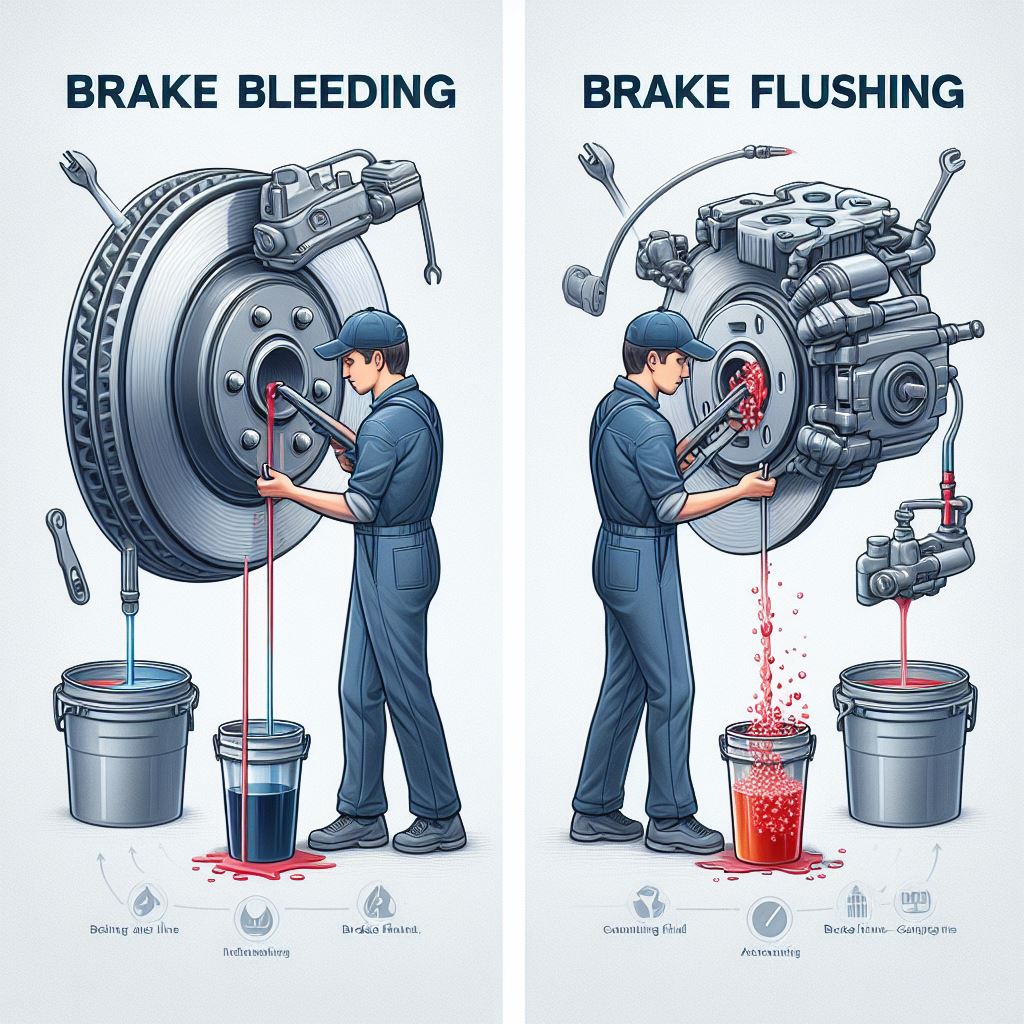
Brake system bleeding and flushing are essential maintenance tasks for all types of vehicles, whether it’s a car, truck, or motorcycle. Let’s dive into what these processes entail and why they are crucial for the proper functioning of your vehicle’s brakes.First, let’s start with brake system bleeding.
This process involves removing the old brake fluid from the system and replacing it with fresh fluid. Over time, brake fluid can become contaminated with air, moisture, and debris, which can affect its performance. Bleeding the system ensures that the fluid is clean and free of any contaminants, allowing for better brake performance and longevity.
Now, onto brake system flushing. This is a more comprehensive process that involves completely replacing all of the brake fluid in the system. While bleeding only removes a portion of the fluid, flushing replaces it entirely.
This is especially important for older vehicles or those that have not had their brake fluid changed in a long time. Flushing helps to prevent corrosion and maintain the integrity of your brake system. But why is it necessary to bleed and flush your brake system? Well, for starters, the air in the brake lines can cause a spongy or unresponsive brake pedal, making it difficult to stop your vehicle quickly.
Moisture in the brake fluid can also lead to corrosion in the brake lines, which can result in leaks and potentially dangerous brake failure. Regular bleeding and flushing can prevent these issues and keep your brakes working as they should. Now, the big question – what type of vehicle requires brake system bleeding and flushing? The answer is simple – all vehicles.
Whether you have a brand-new car or a vintage motorcycle, your brake system needs regular maintenance to ensure safe and efficient operation. It’s always a good idea to consult your vehicle’s owner’s manual for specific recommendations on how often to bleed and flush your brakes.
Cars and Trucks
Brake system bleeding and flushing is a crucial maintenance task for all vehicles, whether it’s a car or a truck. But what exactly does it entail, and which vehicles require this procedure? Simply put, it is the process of removing old brake fluid and replacing it with fresh, clean fluid. This helps to remove any contaminants and air bubbles that may affect the performance of your brakes.
So, if you want to ensure your vehicle’s braking system is in top shape, don’t skip this important task for your car or truck.”
Motorcycles
Maintaining your motorcycle’s brake system is crucial for safe and smooth rides. One essential process is bleeding and flushing the brakes, which removes air and old brake fluid from the system. This ensures proper function and prevents potential brake failures.
But what exactly is involved in this process, and which vehicles require it? From cars to motorcycles, all vehicles with hydraulic brakes should have their systems bled and flushed regularly. Don’t neglect this important maintenance task, and keep your brakes in top shape for a worry-free ride.
RVs and Trailers
Maintaining your RV or trailer’s brake system is crucial for safe travel. One important aspect is bleeding and flushing the system. But what exactly does this entail, and which vehicles need it? Put, bleeding involves removing air from the brake lines, while flushing involves replacing old brake fluid with new.
This helps ensure optimal brake performance and prevents potential issues down the road. All vehicles, including RVs and trailers, should have their brake system bled and flushed regularly to maintain safe and smooth travel. So don’t forget to give your brakes some love and attention!
Frequently Asked Questions [FAQs]
1. Do Vehicles Need Brake Fluid Flush?
Yes, vehicles must have a brake fluid flush performed occasionally to ensure the brakes function as safely and effectively as possible. The brake system is an incredibly important part of any vehicle, and keeping it in top condition is essential.
Brake fluid flushing is a process that involves removing the old and contaminated brake fluid from the system and replacing it with fresh, clean fluid. This helps to prevent wear and tear on the system, as well as improve the overall performance of the brakes.
2. How Often Should You Flush Brake Fluid?
The frequency you should flush your brake fluid will depend on your vehicle type and how often it is used. Generally, it’s recommended that all vehicles have their brake fluid flushed at least once a year and more often if the vehicle is used for a lot of heavy-duty driving.
It’s also important to check with the manufacturer’s guidelines for your vehicle, as this may provide specific instructions for how often you should flush the brake fluid.
3. What Is The Benefit Of Brake Flush?
The benefit of a brake flush is that it helps to improve the overall performance of your vehicle’s braking system. It is important to flush the brakes periodically to keep them working efficiently and effectively.
A brake flush removes contaminants, dirt, or air bubbles that may have built up inside the brake lines over time. This can help reduce brake noise and ensure brakes perform at peak capacity. Additionally, a brake flush ensures that your safety is taken seriously by ensuring the brake system works optimally.
4. How Often Is A Brake Flush Needed?
Typically, a brake flush should be performed every two years or 24,000 miles. However, this can vary depending on the type of vehicle and its braking system. Brake fluid is hygroscopic, which means it absorbs moisture over time.
This can cause corrosion to occur within the braking system. In addition, as brake fluid gets older, it becomes contaminated with dirt and other debris from the braking system. This can lead to decreased brake performance and potentially dangerous situations.
5. What Is Special About All Brake Fluids?
Brake fluids are special in that they are designed to provide lubrication, cooling, and protection against corrosion of the internal components of the brake system. All brake fluids consist of a certain base fluid and a range of additives for specific purposes.
Common types of brake fluid include glycol-ether-based fluids (DOT 3, DOT 4, and DOT 5.1) and mineral oil-based fluids ( DOT 5). The DOT rating indicates the brake fluid’s boiling point, or how hot it can get before it starts to boil.
Conclusion
Brake system bleeding and flushing are important processes that help keep your vehicle’s brakes in optimal condition. The frequency with which you should bleed your brakes will depend on the type of vehicle, how often it is used, and other factors. Additionally, brake fluid flushes should be performed regularly to remove contaminants or air bubbles from the system. For best results, always consult manufacturer instructions to determine the correct procedure for your vehicle.
